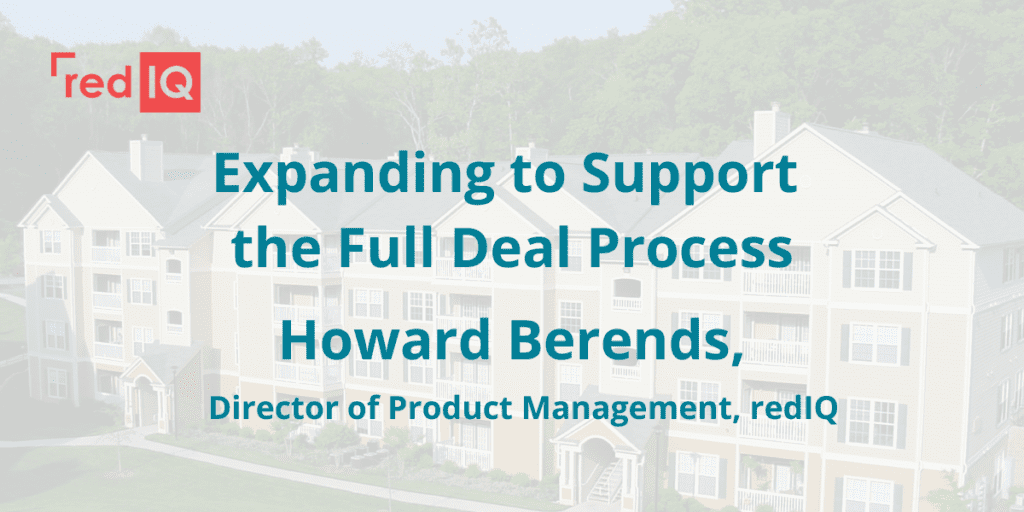From Sourcing to Disposition: Expanding redIQ to Support the Full Deal Process

From Sourcing to Disposition:
Expanding redIQ to Support the Full Multifamily Deal Process
This post was written by Howard Berends, Director of Product Management at redIQ. Want to guide redIQ as we expand our offerings? Email Howard at hberends@rediq.com.
redIQ began with a mission: to transform the data associated with multifamily properties from a disorganized burden to an invaluable asset. We’ve launched a full suite of products to support that mission—dataIQ, our data standardization and analysis platform, valuationIQ, our comprehensive underwriting model, and QuickSync, which enables clients to connect their proprietary models with dataIQ. These offerings allow our clients to run the full acquisition process while capitalizing on the most valuable data available to them: their own.
This data—historical financial data, occupancy data, market data, sales comp data, and data for forward-looking projections—all play a role in going from receiving an email with a BOV to closing a transaction. However, assets do not stop generating data when a deal has closed. Every property produces data daily through the hold period, whether that’s five years or thirty. In my conversations with industry professionals, a consistent message has emerged: the industry lacks software that provides comprehensive support during the hold period.
Despite evolving attitudes, CRE firms tend to lag behind their peers in other industries when it comes to technology adoption. This issue comes from an endemic resistance to change—and a lack of software that addresses real business problems. After numerous conversations with redIQ users, it became clear to me that the multifamily software ecosystem lacks a solution for obtaining value from the data properties generated on an ongoing basis. Today, investors rely on disparate systems to gather and leverage this data for essential purposes. These purposes include measuring the performance of assets post-acquisition by comparing actual operations to both the initial proforma and ongoing projections. Investors and operators must also compare property performance to the market at both the micro and macro levels. At specific intervals during the holding period, investors will utilize this data to perform a sell/hold analysis, deciding whether the best course of action would be to continue to operate, refinance, or sell the asset.
Through the Lifecycle Management Suite (“LMS”), a new set of offerings under development by redIQ, we will support our clients by giving them the ability to capitalize on the data they generate during the hold period—as they produce it. During the LMS development process, we’ve spoken to dozens of clients about their needs post-acquisition. These conversations have been crucial in assisting us as we build and release the first two LMS features: support for Below NOI line items (“BNOI”) and Proforma vs. Actual (“PvsA”).
Live as a free beta in dataIQ as of last week, BNOI and PvsA now enable redIQ users to begin capitalizing upon data produced during the hold period:
- BNOI allows users to upload and map operating statement line items below Net Operating Income (NOI). This feature provides the ability to better view and export to variance analysis tools for asset management or for servicing.
- With PvsA, clients can upload up to three different proformas (budgets, scenarios, etc.) along with historical operating statements and generate an Excel-based variance report. The user can select to view the variances as either a dollar or percentage, and conditional formatting is used to quickly highlight the larger variances. Both features allow our users to compare their assumptions to a property’s actual performance—and to more easily see if corrective action needs to be taken if assumptions and performance vary widely.
While testing BNOI and PvsA before their beta release, investor clients observed that both delivered a more refined understanding of their properties’ health. In addition, clients at the major brokerages using redIQ found they can use these features to provide post-close support for their clients after soliciting relevant documents. Both groups—investors and brokers—have also benefited from consolidating a greater amount of work associated with the full life of a deal in a single destination. Reliance on one, consistent solution results in less human error and more accurate decisions.
The redIQ product team remains committed to bringing more work associated with the life of multifamily transactions into our ecosystem, improving the productivity of investors and all our users. No team should have to rely on ad hoc Excel sheets and workarounds to understand the health of their properties post-acquisition. The Lifecycle Management Suite will eventually provide for the hold period what redIQ provides for multifamily transactions: organized data made translatable into insight and action. BNOI and PvsA have started that process today.
If you’re not a redIQ user and would like to see BNOI and PvsA, as well as the rest of what redIQ offers, please sign up for a demo by using the form below. If you’re a redIQ user, log in here to access these features.
Request A Demo
Transform the analysis and underwriting of your multifamily properties.
About redIQ
For over ten years, redIQ has provided a comprehensive and dependable underwriting service for multifamily acquisition teams, brokers, and lenders focused on mid and large-size assets. redIQ’s solutions lead the industry and support the full underwriting process, from standardizing financial documents to producing a final valuation. With our system, analysis takes less time and decision makers can move forward with greater confidence. redIQ users can close more deals, produce better returns, and spend less time worrying about downside.
